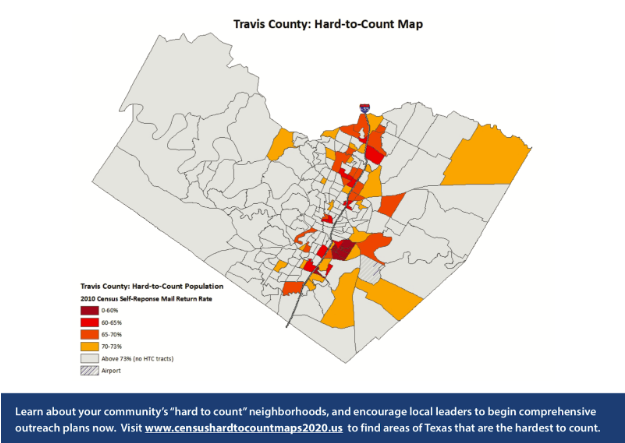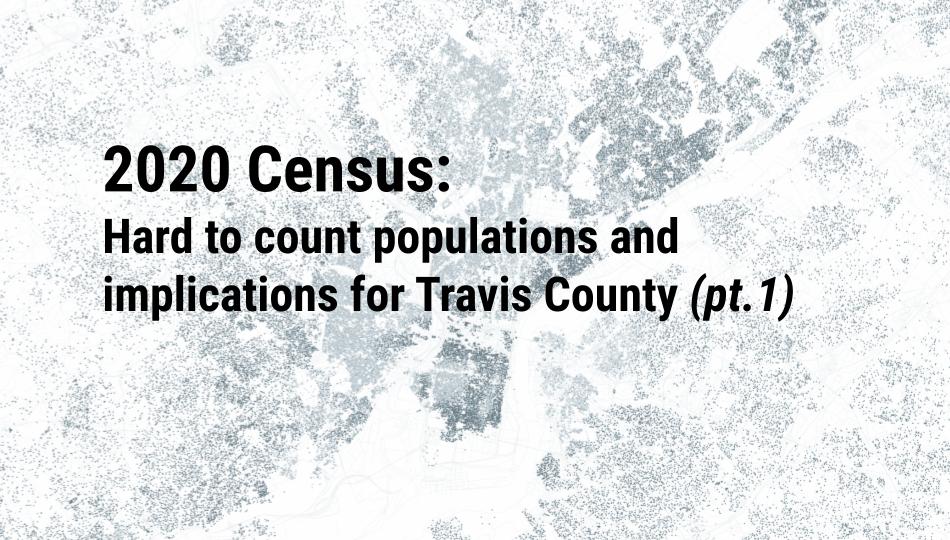Every 10 years, the US Census Bureau runs a count of each person living in the US. We’re honored to have been selected to take part in the Austin-Travis County Census 2020 Complete Count Committee, a volunteer committee tasked with increasing awareness and motivation of residents to respond to the 2020 Census. In addition to our work with the committee, we’ll be providing the community with information on the Census and its challenges. This is the second article of a series covering these issues leading up to the 2020 Census, which launches April 1, 2020. In this post, we outline hard to count populations and why they’re important. Review last month’s post for an overview of the census and why every count matters.
Hard to Count Populations in Travis County
The Census Bureau is tasked with “counting everyone once, only once, and in the right place” every ten years. Months and even years of planning go into achieving this goal. Even with that preparation, Travis County is still at risk of an undercount in 2020. In the event of an undercount, Travis County would lose federal funding and potentially lose political power via fewer congressional seats from Texas. A miscount in the 2020 Census is not something to be taken lightly, nor is the fact that certain populations are at risk of being unaccounted for due to an assortment factors.This is due to that fact that some populations are harder to count than others for various reasons.
Ideally, each household is counted through self-response, which is the cheapest and fastest; this is Plan A. Since self-response doesn’t fully capture the population, the bureau is forced to strategize in person follow-up in order to achieve a complete count; this is Plan B. This has traditionally been done through in-person follow-ups, where census workers attempted to collect responses in person by visiting each ‘non-counted’ residence; 2020 will deploy fewer workers but pair them with technology to achieve the job. “Hard to count” populations are those that don’t submit their self-response via Plan A and might be hard for census workers to locate and record via Plan B.
There are multiple reasons why households do not self-respond. The census bureau has broken these reasons down into four non-exclusive types: hard to locate, hard to contact, hard to persuade, and hard to interview. These archetypes individually make a resident or a household hard to count, and the combination of more than one exceedingly increases the risk of a non-count. Children, people experiencing homelessness, lower income, lower education, English language learners, undocumented immigrations, and racial/ethnic minorities are historically least likely to be properly counted.
About 52% of residents in Travis county are Hispanic or people of color, 18% of the population were born outside of the US and and 21% of the foreign-born population entered the US since 2010. 14% of the population of the county is in poverty and another 16% are near poverty; 7% of the population are children under 5 years old. 6% of households are limited English speaking, 4% are considered “crowded,” 9% are single parent households, and 67% of households are in multi-family housing. These statistics display the prominence of potential “hard to count” populations in Travis County. Additionally, a bit over 2,000 individuals experience homelessness in Travis County on any given night; these individuals risk exclusion from the count entirely. On top of this, in 2010, significant undercounts occurred across large metropolitan areas, college towns, and rural counties. Grad students at UC Berkeley have put together a visualization of hard to count population in the US, broken down by county – explore here.
About 32% of Travis County residents live in hard-to-count neighborhoods; while 25% of Texans live in these tracts. These are census tracts where a quarter or more of the population did not self-respond in 2010. Reaching these residents in 2020 by means of second round of outreach through mailers, a couple of public forums, and some level of direct outreach could cost at least $742,000 dollars. The Census Bureau has predicted that the hard to count metric for Travis county is 25% – meaning that a quarter of the county will likely require follow up for a chance to be fully counted.

Future installments will address the following topics and challenges as they relate to the 2020 Census:
- Tech and the private sector
- Citizenship question
- Funding the census
- Methods: Internet, rural broadband, and data privacy
- District maps, gerrymandering, voting rights and civil rights enforcement
What topics are you interested in? What would you like to be covered? Tweet @AustinTech with census topics you’d like to learn more about.

